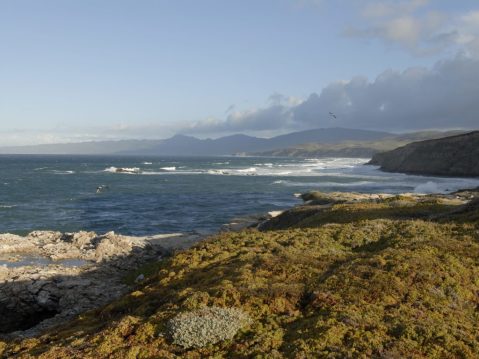New Marine Sanctuary Moves One Step Closer
Chumash National Marine Sanctuary Begins Designation Phase

Conserving the ocean off Point Conception has been a dream for Fred Collins and the Northern Chumash Tribal Council for more than a decade, a hope that took a giant step forward today when the Chumash National Marine Sanctuary officially entered the designation process.
The sanctuary, which stretches offshore from roughly Naples in Santa Barbara County to San Simeon in San Luis Obispo County, not only holds the sacred Chumash site for the Western Gate — from which souls enter the heavens — but ancient solstice alignment rocks, one of the most biologically diverse waters in the world, and a pristine beauty that brings visitors and their revenue to both counties.

Collins “passed into spirit” only 40 days ago at age 71, and his daughter, Violet Sage Walker, who has stepped into his shoes, said the moment was bittersweet. “He struggled so hard to get us where we are today,” she said. “He had a force of nature that took us over the top” and had worked to build a supportive coalition ever since the Monterey marine sanctuary stopped short 40 years ago. Sage Walker, and allies like the Sierra Club, Surfrider, the Wishtoyo Foundation, and thousands of advocates, would continue to build on that support — it’s likely to be three years before the designation nears its final phase — for the sanctuary, which she hoped would be co-managed with the Tribal Council.
In Collins’s application to the National Oceanic and Atmospheric Administration in 2015 to form the sanctuary, he described the rich undersea resources contained in its rocky reefs, submarine canyons, and subsea basins — a unique ecosystem where multiple ocean currents met and supported habitat for threatened species, like the snowy plover, southern sea otter, and leatherback sea turtle, that extended into the eastern Pacific basin. He noted the seafaring heritage of the Chumash, revived with the recent constructions of tomol plank canoes and rediscovered solar, lunar, and stellar knowledge, as well as solstice alignments in coastal areas that continue into now-submerged rock outcrops. As well, the changing tides have buried Chumash sites, which once reached the Channel Islands during the past 10,000 years.
Sign up for Indy Today to receive fresh news from Independent.com, in your inbox, every morning.
The Chumash marine sanctuary would lie between two others — in Monterey and at the Channel Islands — and encompass about 7,000 square miles. It would surround another proposal, a wind energy project in Morro Bay set to produce 30 gigawatts of power by 2030.
The area also includes important fisheries, both recreational and commercial, that landed more than $25 million for the counties’ economies in 2012. Fishing from boats and aquaculture farms for abalone and oysters would be managed in a comprehensive and coordinated way with habitat support in mind, the nomination states.
Congressmember Salud Carbajal has long backed the marine sanctuary and pushed to renew the proposal when it hit a time wall in 2000. “I am thrilled the Biden administration has taken this step to protect our coastal areas from further oil and gas drilling and strengthen our state’s $1.9 trillion coastal economy,” he said in a prepared statement. “Bringing the proposed sanctuary into the designation phase is the result of years of public engagement, and I am grateful that we are one step closer to permanently protecting our coastline for future generations to inherit and enjoy. I am also thankful for the steadfast leadership of the late Fred Collins, Chairman of the Northern Chumash Tribal Council, whose advocacy was instrumental in moving this project forward.”
Area fishermen, however, consider the area already well-managed, said Diane Pleschner-Steele, executive director of the California Wetfish Producers Association, which fears the sanctuary will be an impediment to fishing. Also opposed is the Alliance of Communities for Sustainable Fisheries, which sent comments in June 2020 to NOAA, expressing an acute lack of trust in existing sanctuary management, their belief that the unique qualities attributed to the area actually were fairly common, and a claim that area ports and chambers of commerce did not support establishing a marine sanctuary.
Supporters and opponents will have several opportunities to send their views to NOAA during the four designation steps. The next is “scoping,” in which NOAA requests thoughts and comments through January 10, 2022, on the “sanctuary boundary, compatible uses, threats a new sanctuary would address, how best to promote marine science and education initiatives and other topics” described at sanctuaries.noaa.gov/Chumash-heritage. Virtual public meetings will also be held on December 8 and 13 and on January 6 for verbal comments. The proposal then goes through drafts of a management plan and environmental review, and public comment period for those documents, before a final decision is made by California’s governor and the U.S. Congress.
Support the Santa Barbara Independent through a long-term or a single contribution.




You must be logged in to post a comment.